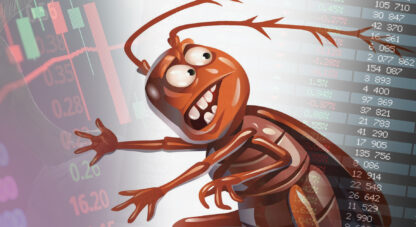October 16 – Wall Street Journal (Alan S. Blinder and Mark Zandi): “Don’t Look Back in Anger at Bailouts and Stimulus… Logic dictates that the size of any stimulus be proportional to the expected decline in economic activity—which was enormous in the Great Recession. The Recovery Act and other stimulus measures were costly to taxpayers, and thus much-maligned. But the slump would have been much deeper without them. The Federal Reserve has also come under attack for its unprecedented actions, especially its quantitative easing or bond-buying programs. Yet QE lowered long-term interest rates and boosted stock and housing prices—all to the economy’s benefit. Yes, QE has possible negative side-effects, but for the most part they have yet to materialize. Policy makers who botched the regulatory job before the crisis and shifted to fiscal restraint prematurely in 2011 can hardly be considered flawless. Yet one major reason why the U.S. economy has outperformed the plodding European and Japanese economies is the timely, massive and unprecedented responses of U.S. policy makers in 2008-09. So let’s get the history right.”
Getting “history right” has been a CBB focal point From Day One. In last week’s media barrage, Dr. Bernanke repeatedly stated that fiscal policy had turned contractionary – (or at best neutral) suggesting that fiscal stringency was a key factor in the Fed sticking with ultra-loose policies. In Friday’s WSJ op-ed, Blinder and Zandi write: “Policy makers who botched the regulatory job before the crisis and shifted to fiscal restraint prematurely in 2011.”
Since the end of 2007, outstanding Treasury Securities (from Fed’s Z.1) have increased $8.302 TN, or 137%. As a percentage of GDP, outstanding Treasuries almost doubled to 83% (from 42%) in seven years. By calendar year, Treasury borrowings increased $1.302 TN (8.8% of GDP) in 2008, $1.506 TN (10.4%) in 2009, $1.645 TN (11.0%) in 2010, $1.138 TN (7.3%) in 2011, $1.181 TN (7.3%) in 2012, $858 billion (5.1%) in 2013 and $736 billion (4.2%) last year.
In nominal dollars, Federal expenditures increased from 2007’s $2.933 TN, to 2008’s $3.214 TN, 2009’s $3.487 TN, 2010’s $3.772 TN, 2011’s $3.818 TN, 2012’s $3.789 TN, 2013’s $3.782 TN and 2014’s $3.897 TN. Federal expenditures spiked during the crisis and remain about a third above 2007 levels.
“US Post Smallest Annual Budget Deficit since 2007” was a Thursday WSJ headline. “The deficit declined 9% from the prior year to $439 billion—around 2.5% of gross domestic product and below the average the U.S. has run over the past 40 years.”
I remember all too clearly the jubilation that surrounded federal budget surpluses in the late-nineties. Supposedly, a disciplined Washington had made tough choices and finally put its house in order. There was even talk of Treasury completely paying off its debts. It was, however, all a seductive Bubble Illusion. In particular, receipts were inflated by Credit excess-induced capital gains taxes (on inflating stock and asset prices) and booming incomes (especially tech and finance related!). Actually, it all seemed obvious even at the time. It didn’t make sense to me that the Fed and analysts were so prone to misinterpreting underlying dynamics.
Blinder and Zandi: “Yes, QE has possible negative side-effects, but for the most part they have yet to materialize.”
There are myriad deleterious side-effects, and anyone paying attention would agree that many have begun to materialize. One prominent consequences of Federal Reserve rate manipulation has been the loss of the markets’ ability to discipline policymaking. How does it ever make sense to allow politicians access to years of virtually free “money”? Ominously, despite Treasury paying basis points to service a large chunk of our outstanding debts, the federal government is still running significant deficits. While outstanding Treasury debt has increased almost 140% in seven years, 2014 interest payments were up only 8% from 2007 (to $440bn). Government social payments, on the other hand, were up 48% from 2007 levels to $1.897 TN.
Slashing Treasury borrowing costs is not the only way the Fed has temporarily boosted the U.S. fiscal position. Funding a nearly $4.5 TN Fed balance sheet with virtually interest-free funding is (for now) a “money”-making endeavor. Last year the Fed remitted “profits” back to Treasury to the tune of almost $100 billion. Reflationary monetary policies have also been instrumental in resurgent Fannie Mae and Freddie Mac. A hiatus in loan losses allowed Fannie and Freddie to remit almost $140 billion in “profits” back to Treasury (funds that should have remained as a capital buffer).
At this point, markets assume Treasury yields will not rise meaningfully in the foreseeable future. And, apparently, a deep recession remains out of the question. Yet Bubbles inevitably burst. Even a typical recession-induced slump in receipts and jump in spending would at this point see the almost immediate return of enormous federal deficits. Then ponder taking away Fed remittances to the Treasury and factor in another GSE bailout -and things deteriorate dramatically. A reasonable forecast would also incorporate a boost in defense spending. In a few short years federal debt would surpass GDP. Worse yet, at any time an unexpected surge in market yields would rather quickly endanger the balance sheets of the Treasury, the GSEs and the Federal Reserve – with nasty ramifications for the banking system, the economy and finance more generally.
Blinder and Zandi: “Logic dictates that the size of any stimulus be proportional to the expected decline in economic activity—which was enormous in the Great Recession.”
I am reminded of an invaluable “Austrian” insight (paraphrased): “The scope of the down cycle is proportional to the excesses of the preceding Credit boom.” From this perspective, there is major problem with conventional “logic.” These so-called “proportional” monetary and fiscal responses have over the past 25 years fueled serial Bubbles – and attendant progressively more dangerous Boom and Bust Dynamics. Especially when it comes to monetary policy, it was recognized a long time ago that the problem with giving central bankers too much discretion was that policy mistakes would invariably be followed by greater blunders.
It’s sad to see Capitalism under such attack in the national discourse. Washington seems only somewhat less despised than Wall Street. Somehow socialist ideas appeal to a growing number of Americans – especially the young. On this score, I’m content to be repetitive: Federal Reserve activism and inflationism bear primary responsibility.
In this week’s Democratic debate, Hillary Clinton stated, “Sometimes Capitalism must be saved from itself” and “It’s our job to rein in the excesses of capitalism so that it doesn’t run amok and doesn’t cause the kind of inequities that were seeing in our economic system.”
I’ll argue passionately the notion that politicians must save Capitalism from itself is the materialization of a dreadful “negative side-effect” of monetary mismanagement. If politicians are determined to get involved, they should foremost insist on sound money. Since politicians have throughout history demonstrated their proclivity for the exact opposite, Capitalism has been essentially entrusted to sound central bank principles. And while this may have not yet materialized to most, central banking has failed. It goes back to flawed doctrine where the Federal Reserve refused to address inflating Bubbles, preferring instead a policy of aggressive post-Bubble reflationary “mopping up.” It goes back to the Greenspan Fed’s tinkering with the markets to the Bernanke Fed’s crisis management QE to the Bernanke/Yellen/Kuroda/Draghi central bank non-crisis open-ended QE.
Regrettably, I fully expect to be defending Capitalism throughout the remainder of my life. I’ll try to explain how Capitalism isn’t – wasn’t – the problem. The culprit instead was unsound finance and deeply flawed monetary management. In short, Capitalism cannot function effectively within a backdrop of unfettered cheap finance. Things appear miraculous during the boom, and then the bust discombobulates.
Contemporary central bank rate administration essentially abandoned the self-adjusting and regulating market system for determining the price of finance – so fundamental to Capitalism. The results have been predictable: gross misallocation of real and financial resources, economic stagnation, financial fragility, wealth redistribution, rising social and geopolitical tension and central bankers absolutely incapable of extricating themselves from inflationism and market manipulation.
I doubt there are too many traders or hedge fund operators these days that would argue against the Monetary Disorder Thesis. While the major indices appeared more quiescent this week, there remains plenty of instability below the surface. The week saw the broader market underperformed the S&P500. The Transports dropped 2%, while the Utilities gained 2%. The Biotechs were again notable for their inability to sustain a rally.
The Brazilian real reversed hard to the downside, dropping 4.3% this week. Brazilian stocks sank 3.5%. The Malaysian ringgit and Indonesian rupiah both declined about 1%. The squeeze in commodities markets gave way to selling. Crude sank 4.8%, as the Goldman Sachs Commodities Index fell 2.7%. Gold and Silver bucked the trend, with these long-term stores of value gaining 1.8% and 1.3%. Also quietly trading more positively, the yen gained 0.7% against the dollar this week, briefly trading back to August highs. Meanwhile, the VIX dropped to a near three-month low 15. Treasury yields dropped.
The thesis remains that the global Bubble has been pierced. In a world of open-ended QE, unprecedented policy activism and Trillions of trend-following and performance-chasing finance, there will be erratic ebb and flow to market activity – including EM. There were more announcements of hedge funds closing shop this week. For the industry overall, I doubt the recent market rally has relieved much pressure. Many funds were likely caught up in the powerful equities, EM and commodities short squeeze.
It seems apropos to note that shorting is not really the inverse of investing on the long side. The risk profiles are altogether different. On the long side, risk is limited. If an investor is right on the research and is willing to wait out market swings, risk is generally manageable. It’s another story on the short-side. Risk is unlimited. You can be right on the analysis but still lose money in a hurry if caught in the vortex of a powerful short squeeze dynamic.
This short squeeze dynamic has come to wield significant general market impact. With hedge fund and ETF industry assets each now at around $3.0 TN, the level of trend-following trading activity is unprecedented. In theory, one would expect such a backdrop to spur market overshooting both on the upside and down. Except that central bankers have repeatedly backstopped the markets to ensure that downside momentum does not gather pace.
In the past, the Fed and central banks used various backstop measures, including rate cuts, QE or simply talk of further policy loosening. Post-August “flash crash” market assurances have included the Fed delaying “lift off” and even chatter of negative rates. The ECB hinted at boosting QE. Chinese officials responded with a laundry list of stimulus and market controls.
By repeatedly intervening to arrest market downside momentum, the Fed and central banks nurtured a backdrop conducive to powerful short squeezes. The current exceptionally speculative marketplace plays right into this dynamic. After all, few (if any) market themes offer the quick trading profit opportunities as squeezing the shorts. And with the faltering global Bubble and elevated risk generally, short positions and bearish hedges had been mounting in recent months.
It’s worth recalling that Nasdaq went on its final speculative melt-up in early 2000, right in the face of rapidly deteriorating industry fundamentals. Short squeezes and a dislocation in equities derivatives played prominently. And there were some decent squeezes and a collapse in the VIX just prior to the 2008 fiasco. Just because the market is within striking distance of record highs does not indicate that the downside of a historic Bubble period isn’t materializing. It would be much healthier if (self-adjusting) markets were capable of letting some air out gradually.
For the Week:
The S&P500 added 0.9% (down 1.3% y-t-d), and the Dow increased 0.8% (down 3.4%). The Utilities jumped 2.3% (down 6.6%). The Banks added 0.3% (down 6.6%), and the Broker/Dealers gained 2.2% (down 7.0%). The Transports dropped 2.1% (down 11.6%). The S&P 400 Midcaps declined 0.6% (down 1.2%), and the small cap Russell 2000 slipped 0.3% (down 3.5%). The Nasdaq100 advanced 1.6% (up 4.8%), and the Morgan Stanley High Tech index increased 0.4% (up 4.6%). The Semiconductors surged 3.7% (down 5.0%), with a three-week gain of 10%. The Biotechs added 0.2% (up 0.5%). With bullion gaining another $21, the HUI gold index increased 0.6% (down 18.2%).
Three-month Treasury bill rates ended the week at zero. Two-year government yields fell four bps to an 18-week low 0.60% (down 7bps y-t-d). Five-year T-note yields declined five bps to a 25-week low 1.35% (down 30bps). Ten-year Treasury yields dropped six bps to 2.03% (down 14bps). Long bond yields declined four bps to 2.88% (up 13bps).
Greek 10-year yields rose nine bps to 7.66% (down 209bps y-t-d). Ten-year Portuguese yields gained three bps to 2.42% (down 20bps). Italian 10-yr yields fell nine bps to a 24-week low 1.60% (down 29bps). Spain’s 10-year yields declined five bps to 1.77% (up 16bps). German bund yields dropped six bps to a 23-week low 0.55% (down one bp). French yields fell seven bps to 0.92% (up 9bps). The French to German 10-year bond spread narrowed one to 37 bps. U.K. 10-year gilt yields declined six bps to 1.80% (up 5bps).
Japan’s Nikkei equities index slipped 0.8% (up 4.8% y-t-d). Japanese 10-year “JGB” yields were unchanged at 0.31% (down 1 bp y-t-d). The German DAX equities index was little changed (up 3.0%). Spain’s IBEX 35 equities index slipped 0.8% (down 0.5%). Italy’s FTSE MIB index added 0.4% (up 17.5%). EM equities were mixed. Brazil’s Bovespa index dropped 3.5% (down 4.8%). Mexico’s Bolsa was about unchanged (up 2.8%). South Korea’s Kospi index added 0.5% (up 6.0%). India’s Sensex equities index increased 0.5% (down 1.0%). China’s Shanghai Exchange surged 6.5% (up 4.8%). Turkey’s Borsa Istanbul National 100 index declined 0.9% (down 8.4%). Russia’s MICEX equities index slipped 0.7% (up 23%).
Junk funds this week saw inflows of $1.5bn (from Lipper).
Freddie Mac 30-year fixed mortgage rates jumped six bps to 3.82% (down 5bps y-t-d). Fifteen-year rates gained four bps to 3.03% (down 12bps). One-year ARM rates slipped a basis point to 2.54% (up 14bps). Bankrate’s survey of jumbo mortgage borrowing costs had 30-yr fixed rates down two bps to 3.88% (down 40bps).
Federal Reserve Credit last week expanded $4.6bn to $4.451 TN. Over the past year, Fed Credit inflated $30bn, or 0.7%. Fed Credit inflated $1.641TN, or 58%, over the past 153 weeks. Elsewhere, Fed holdings for foreign owners of Treasury, Agency Debt last week dropped another $14.1bn to a 23-week low $3.314 TN. “Custody holdings” were up $21bn y-t-d.
M2 (narrow) “money” supply gained $2.1bn to $12.189 TN. “Narrow money” expanded $672bn, or 5.8%, over the past year. For the week, Currency increased $1.2bn. Total Checkable Deposits jumped $25.1bn, while Savings Deposits fell $21.4bn. Small Time Deposits were little changed. Retail Money Funds slipped $1.5bn.
Money market fund assets rose $9.5bn to $2.698 TN. Money Funds were down $35bn year-to-date, while gaining $89bn y-o-y (3.4%).
Total Commercial Paper increased $4.3bn to $1.048 TN. CP increased $41bn year-to-date.
Currency Watch:
October 16 – Bloomberg: “Chinese financial institutions including the central bank sold a record amount of foreign exchange in September, a sign capital outflows were more severe last month than was previously thought. The offshore yuan fell to a two-week low. A gauge of their foreign-currency assets declined by the equivalent of 761.3 billion yuan ($120bn), exceeding an August drop of 723.8 billion yuan… China devalued its currency on Aug. 11 and concerns about further depreciation and slowing economic growth, coupled with the prospect of a U.S. interest-rate increase, are spurring outflows of funds.”
The U.S. dollar index slipped 0.2% to 94.73 (up 4.9% y-t-d). For the week on the upside, South African rand increased 2.0%, the New Zealand dollar 1.8%, the Swiss franc 0.8%, the British pound 0.8%, the Japanese yen 0.7% and the Canadian dollar 0.2%. For the week on the downside, the Brazilian real declined 4.3%, the Australian dollar 1.0%, the Swedish krone 0.6%, the Norwegian Krone 0.4% and the euro 0.1%.
Commodities Watch:
The Goldman Sachs Commodities Index fell 2.7% (down 11.7% y-t-d). Spot Gold increased 1.8% to $1,177 (down 0.6%). December Silver gained 1.3% to $16.03 (up 2.8%). November WTI Crude fell $2.37 to $47.26 (down 11%). November Gasoline sank 6.3% (down 10%), and November Natural Gas dropped 2.8% (down 16%). December Copper slipped 0.5% (down 15%). December Wheat lost 3.3% (down 17%). December Corn fell 1.6% (down 5%).
Global Bubble Watch:
October 14 – Bloomberg (Matthew Martin): “Central bank and sovereign wealth fund assets will shrink by $1.2 trillion, or almost 7%, by the end of the year as China and petrostates including Russia and Saudi Arabia dip into their savings amid slower growth and lower crude revenues, according to UBS… The decline will be driven by China withdrawing its foreign exchange reserves, while oil-producing countries tap foreign assets to support government spending, Massimiliano Castelli, head of global strategy at UBS Asset Management, said… Assets held by central banks and sovereign wealth funds amounted to more than $18 trillion at the end of 2014, according to UBS. Sovereign wealth funds from Oslo to Riyadh and Doha to Moscow are preparing to withdraw savings built up during periods of high oil prices to compensate for a more than 50% slump in the price of crude since August last year. These countries led a surge in state investments in the U.S. and Europe that now totals about $7.3 trillion globally, according to the Sovereign Wealth Fund Institute… ‘This is the beginning of a reversal in the trend we have seen of sovereign wealth funds and central banks accumulating assets,’ Castelli said. ‘We will see more outflows from central banks and sovereign wealth funds over the next few quarters.’”
October 15 – Wall Street Journal (Min Zeng): “Investors are handing the federal government a lot of free money. The pile of Treasury bills sold at an interest rate of zero since the financial crisis topped $1 trillion this summer and grew further this week… On its surface, it makes no sense for investors to lend their cash for free. But with interest rates stuck near zero and supply limited by the looming U.S. debt ceiling, investors who need a place to park their cash have few other options. ‘It is absolutely weird,’ said Thomas Simons, vice president and money market economist in the fixed-income group at Jefferies… ‘This is the world we are living in.’”
October 14 – Bloomberg (Anooja Debnath): “Germany sold five-year government debt with a negative yield for the first time since April amid speculation that the Bundesbank may reach its limit on some bond purchases months before the intended completion of the European Central Bank’s stimulus plan… The ECB tweaked its 1.1 trillion-euro ($1.3 trillion) quantitative-easing program last month by raising its cap on some of the bonds it can buy to 33% per security from 25%…”
October 15 – Reuters: “China has overtaken the United States as the country with the most billionaires…, despite a slowdown in growth in the world’s second-largest economy. The number of U.S. dollar billionaires in mainland China more than doubled to 596 from last year’s 242, according to a list of China’s super-rich published by Hurun Reports Inc. That compares with 537 American billionaires, it said. ‘Despite the slowdown in the economy, China’s richest have defied gravity, recording their best year ever, and creating more wealth than any country has ever done before in a year,’ said Hurun Report chairman Rupert Hoogewerf. China’s booming information technology industry was the fastest-growing source of wealth, with the number of individuals from the industry on the list jumping 43% on last year.”
October 13 – Reuters (Klaus Lauer): “German Finance Minister Wolfgang Schaeuble said… he was unhappy with the low interest rate environment and called for rates to rise ‘sooner rather than later’. His call comes amid a vigorous debate at the U.S. Federal Reserve over whether to push ahead with an interest rate hike this year or hold off until the risks associated with a slowdown in China and other global headwinds become clearer… Speaking at an engineering conference in Berlin, Schaeuble described interest rates as ‘too low’ and said this was causing problems, particularly with regard to pension provisions… Schaeuble said the monetary policy being pursued by central banks meant that there was sufficient liquidity on the markets around the world but he added: ‘I don’t want us to get used to it remaining as it is.’ He warned policymakers against falling into the trap of keeping rates low to actively support the economic outlook, comparing this to the situation of a ‘drug addict’.”
October 12 – Reuters (Hadeel Al Sayegh): “Kuwait’s sovereign wealth fund, one of the world’s largest, is considering selling assets to cover a state budget deficit caused by low oil prices… The Kuwait Investment Authority (KIA), which is estimated to have more than $500 billion of assets, is studying whether to liquidate assets that generate annual returns of below 9%… The KIA’s money is invested across the world, from the United States to Europe to China, in various asset classes including bonds, equities and real estate.”
China Bubble Watch:
October 15 – Bloomberg (Ye Xie): “China’s economy has more imbalances today than it did when Mao Zedong’s Great Leap Forward campaign contributed to a crash half a century ago, according to Goldman Sachs Group Inc.’s Ha Jiming… Fixed-asset investment in the world’s second-biggest economy amounted to 46% of gross domestic product last year, Ha, the vice chairman of Goldman’s money management unit in China, said… That’s more than in 1958, he said, during Mao’s ill-fated effort supercharge China’s transformation into an industrialized nation. ‘The economy is more distorted and imbalanced than the Great Leap Forward,’ Ha…said… While rapid investment has turned China into one of the 21st century’s fastest-growing major economies, it also led to overproduction in industries from steel to cement and sparked concern that some projects will fail to generate the returns needed to service a record build-up of debt. China’s ratio of investment to gross domestic product has exceeded that of Japan in the late 1980s…”
October 15 – Dow Jones (Grace Zhu and Mark Magnier): “China’s banks ramped up lending more than expected in September, a sign that Beijing has had some success in its push to get more credit flowing in the world’s second-largest economy. The bank credit was the highest on record for the month of September. Economists said the rise was the result of a combination of government efforts to ease monetary policy and boost investment and consumption amid weakening demand globally and at home. The People’s Bank of China said Chinese banks issued 1.05 trillion yuan ($165.4bn) worth of new loans in September, up from 809.6 billion yuan in August and above economists’ 850 billion yuan forecast. Total social financing, a broader measurement of credit that takes into account bonds and ‘shadow lending’ by nonbank companies, came to 1.3 trillion yuan in September, up from 1.08 trillion yuan in August.”
October 10 – Reuters (Ruby Lian and Kazunori Takada): “China will step up its crackdown on illegal cross-border money transfers conducted by underground money dealers and offshore companies, as part of efforts to fight corruption, the central bank said… Authorities, including the People’s Bank of China (PBOC), State Administration of Foreign Exchange (SAFE) and the police, will intensify measures to clampdown on illegal money outflows, the PBOC said…”
October 14 – Bloomberg: “China’s imports extended the longest losing streak in six years, underscoring the headwinds to global growth from a re-balancing in the world’s second-largest economy. Imports plunged 17.7% in yuan terms in September from a year earlier, widening from a 14.3% decrease in August and posting an 11th straight decline. Exports fell 1.1% in September in yuan terms… compared with a 6.1% drop in August. The trade surplus was 376.2 billion yuan ($59.4bn).”
October 13 – Reuters (Xiaoyi Shao and Nicholas Heath): “Consumer inflation in China cooled more than expected in September while producer prices extended their slide to a 43rd straight month, adding to concerns about deflationary pressures in the world’s second-largest economy. The consumer price index (CPI) rose 1.6% in September from a year earlier… lower than expectations of 1.8% and down from August’s 2.0%. In a sign of sluggish demand, the non-food CPI was even milder with an annual growth rate of 1.0% in September…”
October 13 – Reuters (Kevin Yao): “Chinese leaders will signal that growth is their priority over reform for the world’s second-biggest economy by setting a growth target of around 7% in their next long-term plan even as the economy loses momentum, policy insiders say. The Communist Party’s central committee will meet from Oct. 26-29 to set out their 13th Five-Year plan, a blueprint for economic and social development between 2016 and 2020… ‘We will have to rely on policy stimulus to safeguard the 7% growth target,’ said an economist from a government think-tank. ‘We should not put financial liberalization at the forefront of economic reforms.’”
October 15 – Reuters (Xiaoyi Shao and Nick Heath): “China’s economic planner said it approved 218 fixed-asset projects worth 1.81 trillion yuan ($285.3bn) in the first nine months of the year, as Beijing looks to drive infrastructure investment to support slowing economic growth. The highest number of approvals were in the transportation and infrastructure sector, which saw 84 projects worth 990.6 billion yuan…”
Fixed Income Bubble Watch:
October 12 – New York Times (Andrew Ross Sorkin): “The first day of Wall Street’s workweek normally comes with the announcement of a corporate merger or two, hence the nickname ‘Merger Monday.’ But these days, a more appropriate moniker might be ‘Manic Monday.’ There was more than $170 billion of deal-making unveiled on Monday. Dell agreed to acquire EMC, the storage provider, in a deal worth about $67 billion, and Anheuser-Busch InBev said it had raised its bid for SABMiller to about $103 billion. Add in a few smaller transactions and you have one of the biggest days ever in Wall Street deal-making. Mergers and acquisitions are on track for a record year. So far in 2015, there have been nearly $3.5 trillion worth of transactions, according to Thomson Reuters. One Wall Street banker described Monday as feeling ‘a little bit like 1986 or maybe 2007.’ If that’s right, these deals do not portend good things, and will likely represent the end — or at least the beginning of the end — of a bull market.”
October 14 – Wall Street Journal (Matt Wirz, Nick Timiraos and Aaron Kuriloff): “Puerto Rico and U.S. officials are discussing the issuance of a ‘superbond’ possibly administered by the U.S. Treasury Department that would help restructure the commonwealth’s $72 billion of debt, people familiar with the plan said… Investors would receive less debt, likely taking an effective ‘haircut’ on the value of their holdings, but would have higher expectations for getting repaid. The proposal would mark an important change in Puerto Rico’s relationship with the U.S. government, which has resisted wading into the island’s debt morass.”
October 14 – Bloomberg (Elizabeth Campbell and Tim Jones): “Illinois will delay payments to its pension fund as a prolonged budget impasse causes a cash shortage, Comptroller Leslie Geissler Munger said… Munger said her office will postpone a $560 million retirement-fund payment next month, and may make the December contribution late. ‘This decision is choosing the least of a number of bad options,’ Munger told… ‘For all intents and purposes, we are out of money now.’”
Federal Reserve Watch:
October 15 – Wall Street Journal (Jon Hilsenrath and Anna Louie Sussman): “The chances of a Federal Reserve interest-rate increase in 2015 are diminishing amid new signs of anemic economic activity, a disappointing development for central bank officials who have been hoping to move this year after a prolonged period of easy-money policies. Lackluster readings on consumer spending, inflation and jobs have virtually eliminated the chances of a move this month. Already, two Fed governors expressed doubts this week about whether the timing will be right this year, and the recent trove of data hasn’t reassured top officials about the economic outlook.”
Central Bank Watch:
October 15 – Reuters (Francesco Canepa): “New efforts are needed to boost price growth in the euro zone as inflation, even excluding energy prices, keeps undershooting the European Central Bank’s target, ECB governing council member Ewald Nowotny said… ‘In my view, it’s quite obvious that additional sets of instruments are necessary,’ Nowotny, who is also the head of Austria’s central bank, said…”
Leveraged Speculation Watch:
October 13 – Bloomberg (Saijel Kishan and Simone Foxman): “Fortress Investment Group LLC and Bain Capital are leading the list of big-name money managers liquidating hedge funds this year as volatility roils global markets. Hedge funds with more than $16 billion have announced shutdowns so far in 2015… Fortress said Tuesday it’s closing its $2.3 billion macro business run by Michael Novogratz after posting losses for almost two years. Bain said last week it’s shuttering its macro fund, which sustained more than three years of declines. ‘There’s an inherent flaw in the hedge fund business model,’ said Sam Won, founder of Global Risk Management Advisors, which advises hedge funds and investors. ‘A lot of investment themes for hedge funds are of a longer tenor than the investor is committed to the fund.’”
October 12 – Financial Times (Robin Wigglesworth): “The cleverest predators of the bond market have suffered a humbling this year, after a heap of high profile bets have gone awry. So-called distressed debt funds seek lucrative opportunities in parts of the credit market where many other investors fear to tread, snapping up the bonds or loans of borrowers either nearing or who have filed for bankruptcy… This somewhat dangerous way to make money is the domain of some of the most respected money managers in the finance industry. But an unhappy confluence of market-wide challenges and idiosyncratic issues has proven exceptionally painful this year. ‘It’s been humbling for most folks,’ says Edwin Tai, a distressed debt portfolio manager at Newfleet Asset Management. ‘Seven years of easy money has made even the most disciplined investors stretch a little.’ Distressed debt hedge funds have lost on average 4.2% in the year to the end of September… So-called special situations vehicles — which also often revel in the world of dodgy debts — have on average fallen 4.4%.”
U.S. Bubble Watch:
October 15 – Bloomberg (Michelle Davis): “The Federal Reserve’s historically low borrowing rate isn’t benefiting corporate America like it used to. It’s more expensive for even the most creditworthy companies to borrow or refinance even as the Fed has kept its benchmark at near-zero the last seven years. Companies have loaded up on debt. They owe more in interest than they ever have, while their ability to service what they owe, a metric called interest coverage, is at its lowest since 2009…The deterioration of balance-sheet health is ‘increasingly alarming’ and will only worsen if earnings growth continues to stall amid a global economic slowdown, according to Goldman Sachs Group Inc. credit strategists led by Lotfi Karoui… ‘The benefit of lower yields for corporate issuers is fading,’ said Eric Beinstein, JPMorgan…’s head of U.S. high-grade strategy. As of the second quarter, high-grade companies tracked by JPMorgan incurred $119 billion in interest expenses over the last year, the most for data going back to 2000… The borrowing has gotten so aggressive that for the first time in about five years, equity fund managers who said they’d prefer companies use cash flow to improve their balance sheets outnumbered those who said they’d rather have it returned to shareholders, according to a survey by Bank of America Merrill Lynch. Since May, stocks of companies that have spent the most buying back their shares have performed even worse than the S&P 500 index. That comes after buyback stocks outperformed the S&P 500 each year since 2007…”
October 14 – CNBC (Telis Demos and Corrie Driebusch): “The initial public offering market has gone from bad to worse. In a clear sign of trouble, supermarket chain Albertsons… delayed its plan to sell stock late Wednesday as retailers’ shares got pummeled. Payment processor First Data Corp. went ahead with its initial public offering, but at a price that was lower than the company had expected. And luxury retailer Neiman Marcus Group Inc. recently decided it needed to wait. The setbacks are the latest for a market that has struggled through the summer as sharp stock-market swings in August and early September trimmed investors’ appetite for risk. Volumes of new issues are down, and a number of technology companies are trading well below their IPO prices, sparking concerns that high-profile companies could put off plans to go public in the months ahead.”
October 16 – Bloomberg (Sho Chandra): “Employment is taking a dive in industries that sell a lot of U.S.-made goods abroad, and things could get worse before they get better. The double whammy to exports from the stronger dollar and cooling overseas markets was bound to hit employment in the world’s largest economy. JPMorgan… has put numbers to the damage. Export-oriented industries have been losing about 50,000 jobs a month for most of this year, after adding 9,000 a month on average in 2014… Recent manufacturing surveys hint the impact could worsen, and the employment erosion may extend into the first half of 2016, he predicts.”
October 10 – MarketWatch (Daniel Goldstein): “Xiāoshòu. That’s how you say ‘For Sale’ in Chinese. And if you’re selling to an all-cash buyer in a U.S. real estate deal, you may need to find a real-estate agent who speaks Mandarin. A joint analysis by… research firm RealtyTrac, and… marketing company Ethnic Technologies, found that 46% of Mandarin Chinese-speaking buyers who purchased U.S. homes in the 17 months ending in May 2015 paid all cash, more than triple the number paying all cash in 2005. Overall, Mandarin speakers are the second largest non-English speaking cash-paying group, totaling nearly 18% of all cash deals, second behind those buyers speaking Spanish at 43%. Among all non-English speaking groups, the share of all-cash buyers of U.S. homes increased from a 20% share in 2005 to a 33% share in the 17 months ending in May 2015.”
October 13 – Reuters (Catherine Ngai and Scott Disavino): “U.S. shale production is expected to fall the most on record in November, extending a nationwide output decline into its seventh consecutive month, according to… the U.S. Energy Information Administration. Total output is set to fall by more than 93,000 barrels per day (bpd) to 5.12 million bpd… That’s the largest monthly cut forecast since data was available in 2007.”
EM Bubble Watch:
October 16 – Bloomberg (Andrea Wong): “Borrowers in emerging markets have started to address a $5 trillion mountain of dollar-denominated bonds and loans, reducing their obligations for the first time in seven years in a move that threatens to cut short a budding rally in currencies from Brazil to Malaysia. Companies in developing nations paid back $38 billion of dollar debt last quarter, $3 billion more than they borrowed in the period and marking the first reduction in net issuance since 2008… Demand for greenbacks among borrowers needing the currency to repay debt is contributing to the largest capital outflows in almost three decades. The borrowing binge, which took off in the wake of the global financial crisis as interest rates tumbled, may now be reversing as economic growth slows, commodity prices fall and lenders demand higher yields… Foreign banks have pared their lending to developing nations since mid-2014, with the amount of loans on their books shrinking by $299 billion to $3.4 trillion in the nine months ended March 31… In the $1.4 trillion corporate debt market, new bond sales dropped to a four-year low of $35 billion last quarter, from a peak of $121 billion in June 2014…”
October 12 – CNBC (Leslie Shaffer): “Emerging markets aren’t just suffering through another market rout—it’s a third wave of the global financial crisis, Goldman Sachs said. ‘Increased uncertainty about the fallout from weaker emerging market economies, lower commodity prices and potentially higher U.S. interest rates are raising fresh concerns about the sustainability of asset price rises, marking a new wave in the Global Financial Crisis,’ Goldman said… The emerging market wave, coinciding with the collapse in commodity prices, follows the U.S. stage, which marked the fallout from the housing crash, and the European stage, when the U.S. crisis spread to the continent’s sovereign debt, the bank said.”
October 13 – Bloomberg (Jonathan Levin): “Brazil’s IPO market is dead. Once the hottest emerging market for initial public offerings after China, Latin America’s biggest economy isn’t even in the top 15 anymore. The nation’s lone IPO this year — FPC Par Corretora de Seguros SA — brought in just $229 million. That’s less than the amount raised in tiny markets like Poland or Trinidad & Tobago and it’s not even 1% of the total from 2007, the very peak of Brazil’s go-go days. Three other would-be issuers — all of them state-backed — have scrapped their plans to go public in 2015. It’s a dramatic turnaround for a country that was once the place to be for foreign investors seeking to take advantage of massive oil discoveries, surging agricultural exports and an up-and-coming consumer base that’s the second largest in the Americas.”
Geopolitical Watch:
October 10 – Reuters: “China said on Friday it would not stand for violations of its territorial waters in the name of freedom of navigation, as the United States considers sailing warships close to China’s artificial islands in the South China Sea. A U.S. defense official told Reuters… the United States was considering sending ships to waters inside the 12-nautical-mile zones that China claims as territory around islands it has built in the Spratly chain. Western media reports quoted U.S. officials as saying the action could take place within a matter of days, but awaited a decision by U.S. President Barack Obama.”
October 14 – South China Morning Post (Cary Huang): “President Xi Jinping’s repeated calls for reform to global governance show he’s determined to put China on an equal footing with the US in managing world affairs, analysts say. The statements also indicated Beijing would pursue a new order that better reflected its increased economic clout, they said. Xi stressed the need to change the status quo in a speech at a study session of the decision-making Politburo…”
October 11 – Wall Street Journal (Damian Paletta, Danny Yadron and Jennifer Valentino-Devries): “Countries toiled for years and spent billions of dollars to build elaborate facilities that would allow them to join the exclusive club of nations that possessed nuclear weapons. Getting into the cyberweapon club is easier, cheaper and available to almost anyone with cash and a computer. A series of successful computer attacks carried out by the U.S. and others has kicked off a frantic and destabilizing digital arms race, with dozens of countries amassing stockpiles of malicious code. The programs range from the most elementary… to software that takes orders from a rotating list of Twitter handles. The proliferation of these weapons has spread so widely that the U.S. and China—longtime cyber adversaries—brokered a limited agreement last month not to conduct certain types of cyberattacks against each other, such as intrusions that steal corporate information and then pass it along to domestic companies. Cyberattacks that steal government secrets, however, remain fair game. This comes after other countries have begun to amass cyberweaponry on an unprecedented scale.”
October 14 – Associated Press (Zeina Karamsarah El Deeb): “Hundreds of Iranian troops are being deployed in northern and central Syria, dramatically escalating Tehran’s involvement in the civil war as they join allied Hezbollah fighters in an ambitious offensive to wrest key areas from rebels amid Russian airstrikes. Their arrival, a regional official and Syrian activists said Wednesday, highlights the far-reaching goals of Russia’s military involvement in Syria. It suggests that, for now, taking on Islamic State extremists in eastern Syria seems a secondary priority to propping up President Bashar Assad. The development is almost certain to increase pressure on Western-backed rebels, who are battling multiple foes…”















